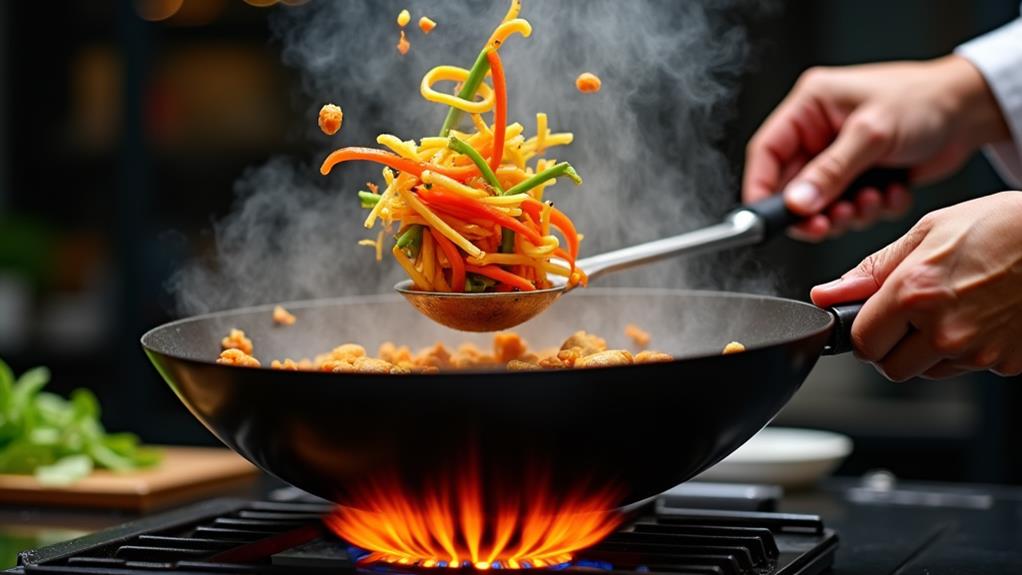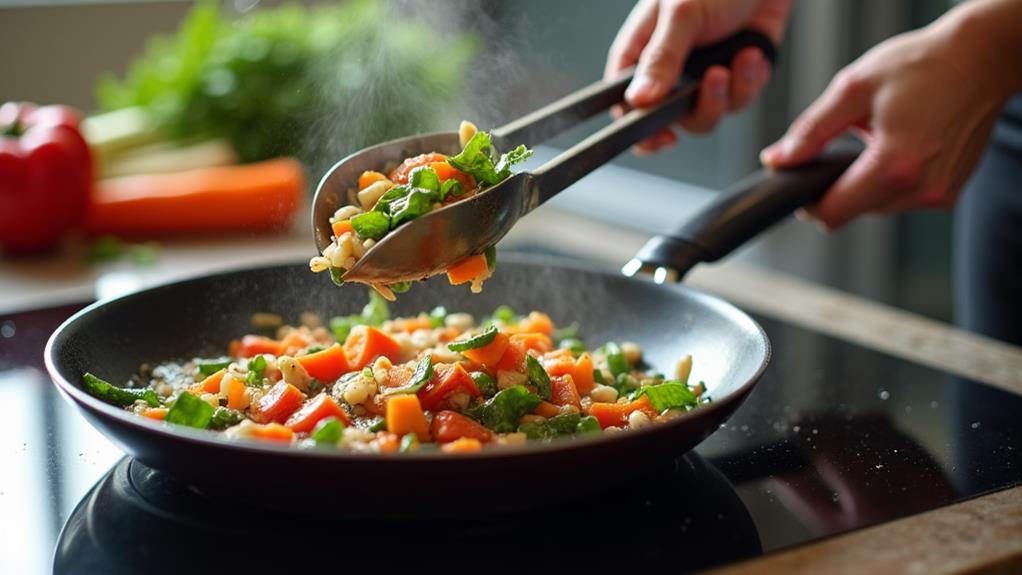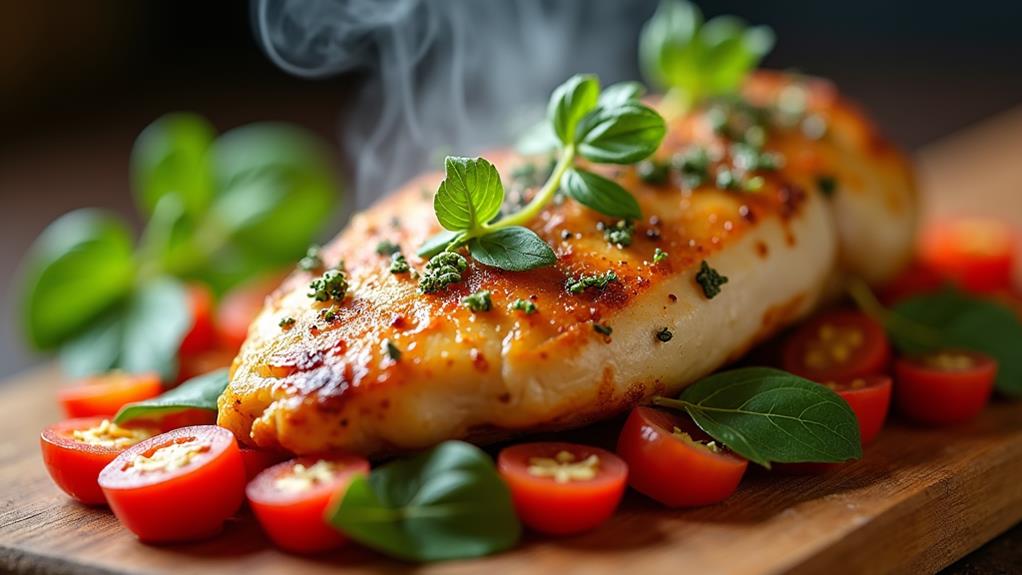To master sautéing and stir-frying, you'll need to control heat effectively, select the right oils, and prepare ingredients properly. Start by preheating your pan on medium-high heat for 2-3 minutes before adding oil. Choose high smoke point oils like vegetable or peanut oil, and add just enough to coat the pan. Slice ingredients uniformly, ensuring smaller pieces for faster cooking. Time your additions carefully, starting with longer-cooking items and aromatics. Avoid overcrowding the pan to achieve crispy textures, and perfect your tossing motion for even heat distribution. Enhance flavors with umami boosters and balance with acidity. The secrets to sizzling success await your exploration.
Heat Control Mastery
When it comes to heat control mastery, understanding your stovetop is crucial. You'll need to familiarize yourself with your burners' temperature gradients and how they respond to flame adjustments.
Start by experimenting with different heat levels, observing how quickly pans heat up and cool down. This knowledge will empower you to make swift, precise adjustments during cooking.
For sautéing and stir-frying, you'll often work with high heat. Learn to manipulate the flame to maintain the perfect temperature, preventing food from burning while ensuring it cooks evenly.
Pay attention to visual cues: a shimmer in the oil indicates it's hot enough to start cooking. As you add ingredients, be prepared to adjust the heat accordingly. Vegetables with high water content may require higher heat to prevent steaming, while delicate proteins might need a gentler flame.
Master the art of heat distribution by moving the pan across the burner. This technique creates even cooking and prevents hot spots.
Oil Selection and Usage
The cornerstone of successful sautéing and stir-frying lies in selecting the right oil.
You'll want to choose an oil with a high smoke point, capable of withstanding the intense heat required for these cooking methods. Neutral-flavored oils like vegetable, canola, or grapeseed are versatile choices, while peanut oil adds a subtle nutty flavor perfect for Asian-inspired dishes.
When it comes to oil temperature, you'll need to heat your pan before adding the oil. This prevents the oil from sitting in a cold pan and potentially breaking down or becoming rancid.
Once your pan is hot, add just enough oil to coat the bottom thinly. Too much oil can lead to greasy food, while too little may cause sticking.
As you cook, pay attention to how the oil behaves. If it starts smoking, you've exceeded its smoke point, and it's time to start over.
Proper Ingredient Preparation
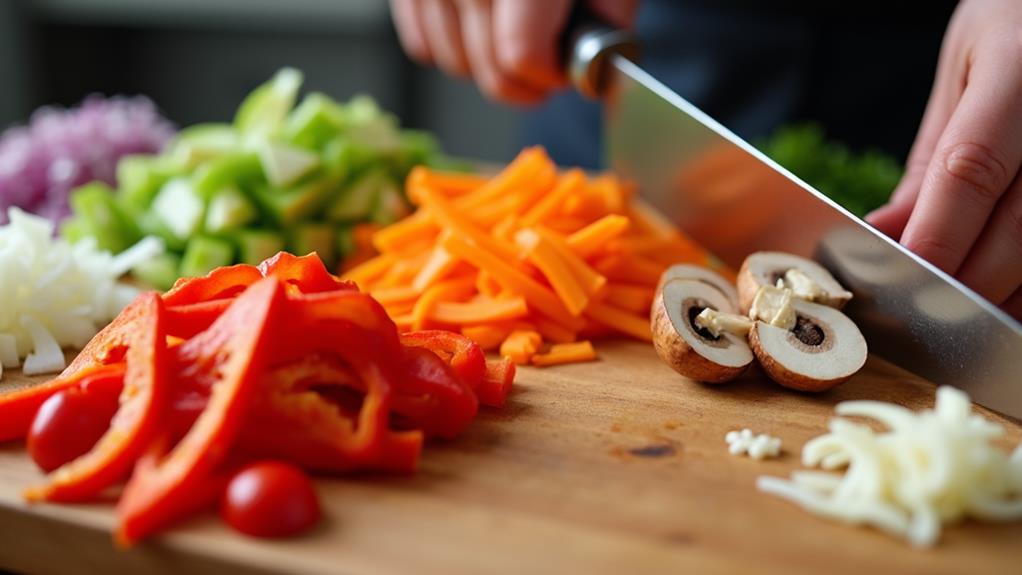
Successful sautéing and stir-frying hinges on proper ingredient preparation. To elevate your culinary game, start by mastering ingredient slicing techniques. Cut vegetables uniformly to ensure even cooking and create visually appealing dishes. For proteins, slice against the grain to maximize tenderness. Remember, smaller pieces cook faster, so adjust your cuts based on cooking time and desired texture. Consider incorporating seasonal ingredients, such as root vegetables, to enhance the flavor profile of your dishes.
Next, focus on seasoning balance. Marinate meats beforehand to infuse flavor and tenderize. For vegetables, season just before cooking to prevent moisture loss. Don't shy away from experimenting with spice blends and herb combinations to create innovative flavor profiles. Consider the cooking time when adding seasonings; delicate herbs should be introduced later to preserve their essence.
Organize your prepped ingredients in order of cooking time, placing those that require longer cooking nearest to your cooking surface. This streamlined approach ensures a smooth cooking process and prevents overcooking.
Choosing the Right Pan
When choosing the right pan for sautéing and stir-frying, you'll want to consider both the material and heat conductivity of the cookware.
The size and shape of the pan also play crucial roles in achieving optimal cooking results.
You'll find that selecting the appropriate pan can significantly impact your culinary success, ensuring even heat distribution and proper ingredient movement during cooking.
Material and Heat Conductivity
For successful sautéing and stir-frying, choosing the right pan is crucial. When selecting your pan, consider the material types and their heat transfer properties. Different materials conduct heat at varying rates, affecting your cooking process and results.
Stainless steel pans are durable and versatile, but they don't distribute heat as evenly as some alternatives. Aluminum, on the other hand, excels in heat conductivity, ensuring quick and uniform cooking. For the best of both worlds, look for stainless steel pans with an aluminum core. These combine durability with excellent heat distribution.
Copper pans are prized for their superior heat conductivity, allowing for precise temperature control. However, they're often expensive and require more maintenance.
Cast iron pans, while slow to heat up, retain heat exceptionally well and are ideal for dishes that need consistent temperature.
For stir-frying, consider a carbon steel wok. It heats quickly and evenly, perfect for high-heat cooking.
Whichever material you choose, ensure it's compatible with your cooktop and cooking style. Remember, the right pan can elevate your sautéing and stir-frying techniques, leading to more innovative and delicious results.
Size and Shape Matters
The size and shape of your pan play a crucial role in achieving optimal results when sautéing and stir-frying. When selecting a pan, consider the cooking techniques you'll be using and the types of ingredients you'll be preparing. A wide, shallow pan with sloped sides is ideal for sautéing, allowing you to easily toss and flip ingredients.
For stir-frying, a deep, round-bottomed wok is the traditional choice, but a large, flat-bottomed skillet can work well too.
Think about the vegetable cuts and ingredient shapes you'll be working with. Smaller pans are great for delicate items or smaller portion sizes, while larger pans accommodate more substantial ingredients and longer cooking times. The right pan size ensures even heat distribution and prevents overcrowding, which can lead to steaming instead of browning.
Consider how your pan choice affects texture contrast, flavor balance, and color combinations in your dishes. A properly sized pan allows ingredients to cook evenly, maintaining their individual textures and flavors.
Timing and Sequencing Techniques

When sautéing or stir-frying, mastering the order of ingredient addition and heat management is crucial for achieving perfect results.
You'll want to preheat your pan to the appropriate temperature before adding any ingredients, ensuring that you're ready to cook as soon as everything hits the hot surface.
As you add ingredients, consider their cooking times and textures, starting with those that take longer to cook and gradually incorporating quicker-cooking items, all while maintaining consistent heat throughout the process.
Order of Ingredient Addition
Successful sautéing and stir-frying rely heavily on the correct order of ingredient addition. To master this technique, you'll need to consider ingredient compatibility and flavor layering.
Start by adding aromatics like garlic, ginger, or onions to your hot oil. These create a flavorful base for your dish. Next, introduce proteins such as meat or tofu, allowing them to brown and develop a rich taste.
Once they're nearly cooked, it's time for vegetables. Add firmer vegetables first, as they require more cooking time. Carrots, broccoli stems, and bell peppers should go in before softer vegetables like mushrooms or leafy greens. This ensures all ingredients are cooked to perfection without becoming mushy.
As you near the end of cooking, incorporate quick-cooking items like bean sprouts or pre-cooked noodles. Finally, add any sauces or seasonings to bring your dish together.
Preheating and Heat Management
Proper ingredient sequencing goes hand-in-hand with effective heat management. To master sautéing and stir-frying, you'll need to harness the power of preheating techniques and temperature settings.
Start by heating your pan over medium-high heat for 2-3 minutes before adding any oil. This ensures even heat distribution and prevents sticking. Once the pan is hot, add your oil and swirl it to coat the surface.
As you cook, maintain consistent heat by adjusting your burner's temperature. For delicate ingredients, lower the heat slightly to prevent burning. When adding new ingredients, be prepared for a temporary drop in temperature. Counteract this by increasing the heat briefly, then returning to your original setting.
Keep ingredients moving constantly to promote even cooking and prevent scorching.
For optimal results, invest in a heavy-bottomed pan that retains heat well. This will help maintain steady temperatures throughout the cooking process.
Avoiding Pan Overcrowding
One of the most common mistakes in sautéing and stir-frying is overcrowding the pan. When you pile too many ingredients into your skillet, you'll end up steaming your food instead of achieving that coveted crispy texture. To avoid this pitfall, focus on maintaining proper ingredient ratios and portion sizes. Divide your ingredients into batches if necessary, ensuring each piece has enough space to sizzle and brown.
By avoiding overcrowding, you'll experience significant texture differences in your dishes. Your vegetables will remain crisp-tender, and meats will develop a delicious caramelized exterior. This approach also helps balance flavors more effectively, as each ingredient has the opportunity to cook properly.
The visual appeal of your dishes will improve, too, with vibrant colors and appetizing browning. Consider ingredient compatibility when planning your sauté or stir-fry. Group items with similar cooking times together to maintain consistency.
Implement smart meal prep strategies by cutting ingredients into uniform sizes, which will help prevent overcrowding and ensure even cooking. Remember, a less cluttered pan leads to more flavorful, well-textured dishes that'll impress your diners and elevate your culinary skills.
Perfecting the Tossing Motion
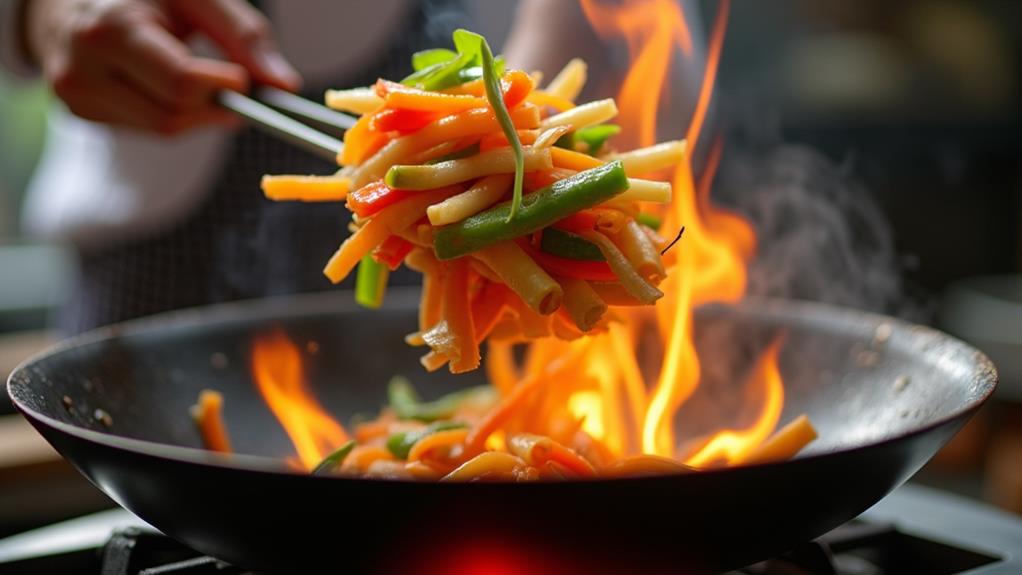
Have you ever wondered what separates amateur cooks from seasoned chefs when it comes to sautéing and stir-frying? It's all in the toss. Perfecting the tossing motion is a crucial skill that elevates your cooking game and ensures even heat distribution and ingredient incorporation.
To master this technique, start by practicing with dry beans or uncooked rice in a cool pan. Grip the handle firmly and use your wrist to quickly jerk the pan forward and upward. As the ingredients begin to lift, pull the pan back to catch them. The key is to develop a smooth, fluid motion that becomes second nature.
As you progress, focus on hand coordination, using your free hand to stabilize the pan or adjust heat as needed. Once you're comfortable with the basic tossing techniques, try incorporating a slight circular motion to further mix ingredients.
Common Flavor-Enhancing Techniques
While mastering the tossing motion is key, it's the flavor-enhancing techniques that truly make your sautéed and stir-fried dishes shine. To elevate your culinary creations, experiment with umami boosters like soy sauce, fish sauce, or miso paste.
Incorporating a fusion of flavors, similar to how honey mustard chicken combines sweet and tangy elements, can add depth and complexity to your dishes. Don't overlook the power of herb infusions; fresh herbs like basil, cilantro, or thyme can infuse your oil with aromatic enhancements before you begin cooking.
Balance is crucial in creating memorable flavors. Incorporate acidity through citrus juices or vinegars to brighten your dish and cut through rich flavors.
Layer your seasonings by adding spices at different stages of cooking, allowing for a more nuanced taste profile. Create flavor contrasts by combining sweet notes with savory elements, such as adding a touch of honey to a spicy stir-fry.
Experiment with texture variations by incorporating nuts or seeds for crunch. Finally, don't underestimate the impact of marinades; they can transform your proteins and vegetables, infusing them with complex spice blends and tenderizing them for a superior eating experience.
Finishing Touches and Presentation

Perfecting your sauté or stir-fry doesn't end when the heat is turned off. The finishing touches and presentation are crucial elements that elevate your dish from good to extraordinary.
As you plate your creation, consider the interplay of colors, textures, and flavors to create a visually stunning and appetizing masterpiece. Incorporating a vibrant element like a grilled vegetable platter can enhance your dish's visual appeal and provide a delightful contrast in flavors.
Employ innovative garnish techniques to add depth and interest to your dish. Experiment with edible flowers, microgreens, or delicately carved vegetables to introduce pops of color and intrigue.
Pay attention to plate presentation, using the rule of thirds to create balance and visual appeal. Color contrast is key; pair vibrant vegetables with neutral proteins to make each element stand out.
To enhance your dish's texture balance, consider these final touches:
- Sprinkle toasted nuts or seeds for a satisfying crunch
- Drizzle a complementary sauce in an artistic pattern
- Add a dollop of flavored foam for a modern twist
Master the art of sauce drizzling to add both flavor and visual interest. Remember, portion control is essential for a well-balanced plate.
Frequently Asked Questions
Can You Sauté or Stir-Fry Without Oil?
Yes, you can sauté or stir-fry without oil! Embrace innovative oil alternatives like broth, wine, or water for a healthier twist. You'll unlock new flavors and enjoy the health benefits of reduced fat intake. Get creative in your kitchen!
How Do You Prevent Vegetables From Becoming Soggy When Stir-Frying?
To keep your veggies crisp, crank up the heat and cook lightning-fast. You'll want to stir-fry in small batches, ensuring each piece gets its moment in the spotlight. Don't overcrowd the pan—it's a veggie party, not a mosh pit!
Is It Necessary to Marinate Meat Before Stir-Frying?
You don't always need to marinate, but it's a game-changer! A quick marinade enhances flavor and tenderizes meat. For innovative stir-fries, try infusing your proteins with bold, unexpected flavors before hitting the wok.
What's the Difference Between Sautéing and Pan-Frying?
You'll find sautéing techniques involve quick cooking with less oil, while pan-frying tips focus on longer cooking times with more fat. Sautéing's ideal for tender cuts, whereas pan-frying's perfect for achieving a crispy exterior on heartier foods.
Can You Use Frozen Vegetables for Stir-Frying?
Did you know 75% of households use frozen veggies? You can definitely stir-fry them! Just thaw and pat dry first. Adjust cooking time downwards, as they're pre-cooked. It's a game-changer for quick, innovative meals with minimal prep.
Final Thoughts
You've now unlocked the sizzling secrets of sautéing and stir-frying, equipping yourself with a culinary arsenal that'll transform your cooking. Remember, practice makes perfect, so don't be afraid to experiment with different ingredients and techniques. As you hone your skills, you'll find that these methods become second nature, allowing you to create delicious, perfectly cooked dishes with ease. Keep your pan hot, your ingredients fresh, and your creativity flowing. Happy cooking!

